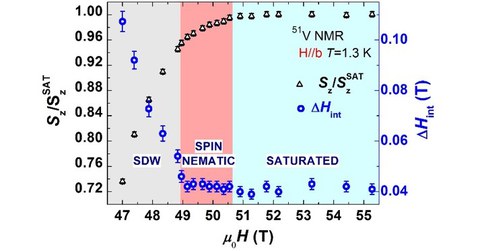Dec 19, 2017
Research: Evidence for spin nematicity in LiCuVO4

Open triangles represent the normalized spin polarization, Sz/SzSAT, up to 56 T for H//b, shifting in accordance with high-field magnetization. However, the NMR linewidth (open blue circles) is unchanging around 49 T, as expected in theory.
Frustrated magnetism has generated interest over the years due to the emergence of novel states, most notably when exposed to high magnetic fields. According to theoretical work, bound magnon pairs can condense in cases where competing exchange interactions occur, thus forming a new quantum phase, referred to as a quantum spin-nematic state. Spin nematicity can be compared to the classical nematic order found in liquid crystals. Some years ago, it was proposed that LiCuVO4, a frustrated magnetic compound consisting of spin-½ Cu2+ chains, was a good candidate for exhibiting spin-nematic order. However, experimental evidence remained elusive due to the high magnetic fields required and the sensitivity of spin nematicity on sample defects.
A high-quality LiCuVO4 sample was grown at the Max-Planck-Institute for Solid State Research in Stuttgart and together with scientists from three of the EMFL (European Magnetic Field Laboratory) facilities (Toulouse, Dresden, and Grenoble), clear evidence was provided in support of the presence of the spin-nematic state. For that, nuclear magnetic resonance (NMR) measurements in pulsed magnetic fields were utilized. The experiment posed a technological challenge due to the short data-acquisition time. For the H || b orientation, magnetic fields above 51 T were necessary, thus precluding the possibility of measurements in DC magnetic fields. A newly constructed homogeneous pulsed-field magnet with a rise time of 70 ms was utilized in combination with a spin-echo sequence with sufficiently short pulses to allow for a bandwidth of 1.2 MHz.
The “tour de force” 51V (NMR) measurements were performed in pulsed magnetic fields up to 56 T which demonstrate the developing homogeneous local magnetization without any transverse dipolar (vector-type) order (see Figure), in agreement with theoretical predications for a spin-nematic state. These results prove the efficacy of NMR in pulsed magnetic fields as a new technique now available within the SFB 1143.
A. Orlova, E. L. Green, J. M. Law, D. I. Gorbunov, G. Chanda, S. Krämer, M. Horvatic, R. K. Kremer, J. Wosnitza, G. L. J. A. Rikken,
Nuclear Magnetic Resonance Signature of the Spin-Nematic Phase in LiCuVO4 at
High Magnetic Fields,
Phys. Rev. Lett. 118, 247201 (2017) (arXiv)
F. Mila
Viewpoint: Closing in on a magnetic analog of liquid crystals,
Physics 10, 64 (2017)
